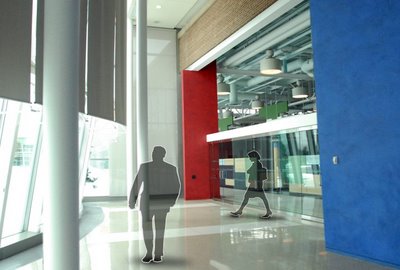You've worked hard, learned plenty, and now you're hanging out your shingle as a motion graphics artist. The question is, where will you practice and how do you get the gigs? There are many avenues of approach with regards to employment in the field, and it's pretty important that you take the time to determine what would suit you and your lifestyle best before you start looking. In a nutshell, you could seek... 1) Full-time, salaried 2) Full-time, contract 3) Part-time, contract 4) Freelance.
As a salary wo/man, you'll have a steady gig with predictable income, health benefits, technology budgets, technical support, retirement plans and, if you're lucky, a games room with a ping pong table. The downside is that you'll be working a daily grind. If it's a good, challenging, rewarding grind then you're doing well, but if it's not, you'll find yourself bound by the 'golden handcuffs'.
Full time contract usually offers a bit more flexibility time-wise, possibly at the expense of health benefits and guaranteed employment. Be prepared to bounce from gig to gig at a rapid pace. This is a great approach for beginners, as you'll get exposed to many different visual strategies and approaches and make lots of contacts for possible future freelance work. Befriend the producers, do good work, and it'll pay dividends in the future.
Part-time contract and freelance often work hand-in-hand: it's nice to have a steady contract (say, a day or two a week) to 'smooth out' the cyclical nature of freelancing. And while freelancing offers the most freedom, it takes a long time to establish yourself with the clients who will pay you what you're worth, and keep coming back for more. You're also never done working: it's a tricky balancing act, and you must remember that when you're pulling 18 hour days on a project, you also have to be concurrently seeking out your next gig. And don't forget that if you're freelancing, you have to build in the cost of software purchase/upgrades, hardware, office supplies, internet and telephone, desks, and chairs, and space for your office. It all adds up, and it can be easy to miss the forest for the trees if you're not careful. Most importantly, make sure that you get a good accountant right off the bat, as there are many financial incentives and opportunities to be had when you work for yourself.
So, with all that in mind, here are some links to job resources on the web. You'll find that some are more regional than others, and I would invite you to send in your own links ("alan" +followed by the 'at' symbol+ "effektor" =then 'dot'= "ca")that I will add as they arrive.
Motionographer (great for the high-end gigs, largely but not exclusively American, often NY/LA.)
Playback Mag (mostly Canadian listings, and not just motion graphics)
Mograph Jobs board (International, tending towards America)
Media Job Search Canada (Canadian, obviously. Not just MG gigs.)
DesignInMotion / 2-Pop Job Forum (International, tending towards America)
MGLA: Jobs (Los Angeles/ SoCal)
MGLA: Jobs Wanted (Post YOUR talents here- Los Angeles, SoCal)
Mandy.com (Global, OK posting propagation depending on your region. Many Low/No pay jobs for students and beginners)
xplsv.tv (USA generally, not many posts yet but seems to be improving)
Friday, October 27, 2006
Where To Get The Gigs
Posted by
Alan Shisko
at
10/27/2006 11:05:00 AM
0
comments
![]()
Thursday, October 19, 2006
Giving Flat Stuff Depth, plus... Awards!

This was a tricky sort of a project. The client came to me and said, "We've got a new building that some of our employees will be moving to, and we need a video to get them jazzed about the facility". The only creative that I would have to work with would be a bunch of still photos. What to do! It would be easy enough to drop them on a timeline with some pan-and-scan and music, but it called for something with a bit more visual dynamism. I decided to use the 'ole "Simulated 3d" look.
Update: This technique is also referred to as the "Ken Burns" (or maybe it's Ben Kurns) effect. Once you've probed my page, do check out another 'how to' at Bob Donlon's excellent blog.
Further Update: A debate broke out on the After Effects list that this is not, in fact, the 'Ken Burns' effect. Decide for yourself at the wikipedia article discussing it. One might argue, though, that this technique needs a name, and so I might humbly suggest calling it the "Alan Shisko Effect" :)
The premise is simple: using photoshop, cut elements out of a picture so that you have (at a minimum) foreground, mid-ground and background layers. Bring it in to After Effects, distribute the layers in a 3d composition along the Z axis (the back and forth dimension) with some scaling applied to match everything up visually, then make a little camera move. If done carefully, you'll end up with an effect that looks as though you made the shot in the actual building with a dolly or track.
Take a look at the video (Quicktime, 22mb, 2:30) to see the final result, then watch this clip (Quicktime, 9.5mb, 11 minutes) to see an overview of the technique in production.
It wasn't just the client that was happy with the end results: the piece garnered a Gold at the 2006 Promax/BDA awards in New York this past spring! Whoo hoo! And that was on top of a silver awarded earlier in the same ceremony!
Posted by
Alan Shisko
at
10/19/2006 11:33:00 AM
3
comments
![]()


